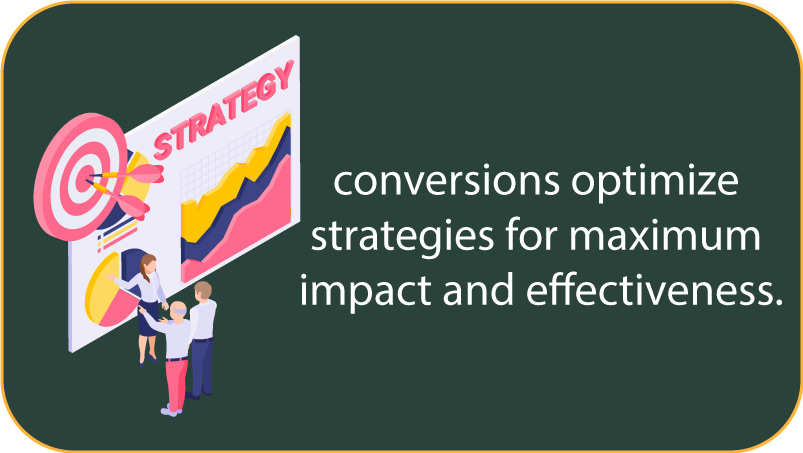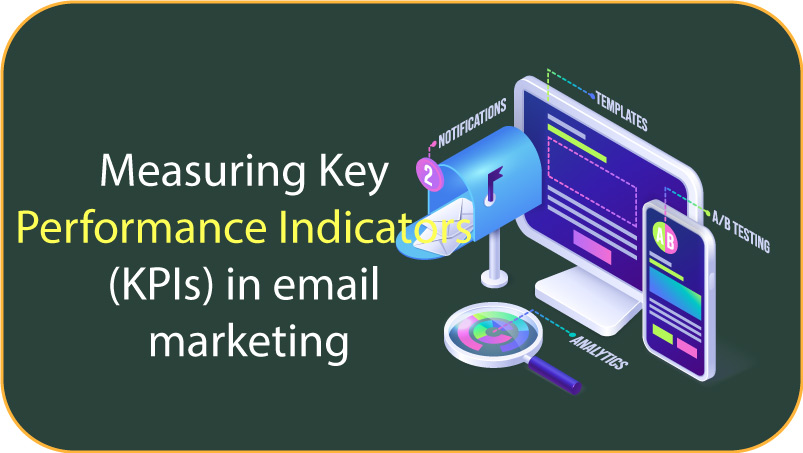Navigating the Future: Key Industry Trends Shaping Digital Marketing
In the fast-paced world of digital marketing, staying ahead of the curve is essential for businesses and marketer

Introduction
Email marketing is a pivotal component of any effective digital marketing strategy. It serves as a direct channel for businesses to communicate with their target audience, fostering relationships that can translate into conversions and sales. However, sending out emails blindly without gauging their impact is insufficient. To truly evaluate the success of your email marketing endeavors, you must track and analyze key performance indicators (KPIs). Using them to enhance campaigns. Metrics like open rates and conversions optimize strategies for maximum impact and effectiveness.

In the dynamic landscape of digital marketing, the significance of email marketing cannot be overstated. It functions as a direct conduit for businesses to establish and nurture connections with their intended audience, creating a pathway that can lead to meaningful conversions and increased sales. Yet, the effectiveness of email campaigns goes beyond mere communication; it hinges on a strategic understanding of their impact. Simply dispatching emails without a comprehensive assessment falls short. To authentically gauge the triumphs and areas of improvement in your email marketing initiatives, diligent tracking and analysis of Key Performance Indicators (KPIs) become imperative. This holistic approach delves into the core of email marketing, unraveling valuable insights and providing a roadmap for optimizing campaigns to achieve maximum impact. In essence, the strategic deployment of KPIs becomes a linchpin for refining and enhancing the overall effectiveness of email marketing strategies.
Understanding the Concept of KPIs in Email Marketing
Email marketing, a powerful means of audience engagement, requires an evaluative framework to measure its impact. Key Performance Indicators (KPIs) step into this role as quantifiable metrics that provide a comprehensive understanding of the performance and effectiveness of email marketing campaigns. These metrics, including open rates, click-through rates, conversion rates, and revenue generated, offer a nuanced view of campaign success. By vigilantly monitoring these KPIs, businesses gain insights into effective strategies and pinpoint areas for enhancement in their email marketing approaches. The strategic use of KPIs becomes instrumental in shaping data-driven decisions that optimize campaigns and elevate their overall impact.
Understanding the essence of Key Performance Indicators (KPIs) in email marketing is crucial for assessing and enhancing campaign impact. KPIs serve as a lens through which trends and patterns in customer behavior come into focus, providing marketers with the insights needed to optimize emails for increased engagement and conversions. When confronted with consistently low open rates, for example, KPI analysis prompts strategic interventions, such as experimenting with diverse subject lines for improvement. Similarly, lackluster click-through rates signal the need for more compelling content. Through this process of continuous evaluation and adjustment guided by KPIs, marketers are empowered to make informed, data-driven decisions that elevate the overall efficacy of their email marketing endeavors, creating campaigns that resonate more effectively with their target audience.
Why KPIs are Essential in Email Marketing
While undeniably valuable for businesses, falls short without a robust performance evaluation mechanism. Key Performance Indicators (KPIs) emerge as indispensable elements in this landscape, offering crucial insights into campaign performance. These measurable values, including open rates, click-through rates, conversion rates, and revenue generated, serve as benchmarks for gauging success and identifying areas in need of refinement. In essence, KPIs are the compass guiding marketers, allowing them to distinguish effective strategies from those that demand optimization. The strategic deployment of KPIs in email marketing ensures a nuanced understanding of campaign effectiveness, enabling businesses to make informed decisions and fine-tune their approaches for maximum impact and sustained success in the ever-evolving digital landscape.
Key Performance Indicators (KPIs) serve as a crucial instrument in deciphering audience behavior trends. A low open rate often signals unengaging subject lines, prompting a need for experimentation and improvement. Similarly, a subpar click-through rate indicates that content may lack the compelling elements necessary to drive audience action. By strategically optimizing elements such as subject lines, content, or design based on insights gleaned from KPI analysis, businesses can elevate engagement levels and fortify conversion rates. This iterative process, guided by KPI-driven insights, allows businesses to tailor their email marketing strategies to align more closely with audience preferences, ensuring that each campaign resonates effectively and contributes to the overarching goals of the marketing endeavor.
Moreover, Key Performance Indicators (KPIs) play a pivotal role in assessing the success of specific campaigns and identifying trends over time. The capability to make informed, data-driven decisions empowers continuous optimization of email marketing strategy for maximum impact. KPIs provide a lens into areas with low click-through rates, enabling marketers to strategically address them. This involves the creation of more compelling content, refining campaigns, and ultimately enhancing the likelihood of conversions. The iterative nature of KPI-driven decision-making ensures that email marketing strategies evolve dynamically, staying attuned to audience preferences and consistently delivering impactful content for sustained engagement and conversion success.
In summary, KPIs are indispensable in email marketing, providing invaluable insights into campaign performance. Through consistent tracking and analysis, businesses can refine their strategies, boost engagement, and drive more conversions.
Commonly Used KPIs in Email Marketing
Effectively measuring the success of email marketing campaigns necessitates the utilization of several key performance indicators (KPIs). These metrics shed light on how emails perform and offer insights into the overall effectiveness of the strategy. Some commonly used KPIs include:
By diligently tracking and analyzing these Key Performance Indicators (KPIs), businesses gain valuable insights into the performance of their email campaigns. This analytical approach allows for a nuanced understanding of campaign effectiveness, enabling informed decision-making for optimization. The data derived from KPIs serves as a guide for refining strategies, enhancing engagement, and making continuous improvements to email marketing efforts, ensuring that each campaign is strategically aligned with business goals for maximum impact and success.
How to Improve Your Email Marketing KPIs
To boost email marketing KPIs and optimize campaign effectiveness, creating compelling content, segmenting email lists, and regularly testing and analyzing campaigns for continuous improvement, businesses can implement several key strategies:
Implementing these strategies empowers businesses to elevate their email marketing Key Performance Indicators (KPIs), leading to more effective campaigns. The incorporation of personalized subject lines, compelling content, targeted segmentation, and rigorous testing contributes to increased engagement and conversions. However, the journey doesn’t end with implementation—consistent monitoring and analysis are imperative for ongoing improvement and optimization. By actively tracking KPI trends and making data-driven adjustments, businesses ensure that their email marketing strategies remain dynamic and aligned with evolving audience preferences. This iterative process not only enhances the immediate impact of campaigns but also establishes a foundation for sustained success in email marketing endeavors.
How to Measure KPIs in Email Marketing
Measuring Key Performance Indicators (KPIs) in email marketing is vital for evaluating campaign effectiveness and guiding data-driven decisions. Analyzing metrics like open rates, click-through rates, and conversions offers crucial insights into the performance of email campaigns. This data empowers businesses to refine and optimize their email marketing strategies continuously. Analyzing recipient engagement and conversion behaviors empowers businesses to make informed decisions, enhancing overall email campaign effectiveness. This approach ensures sustained success in connecting with and influencing the target audience. Here’s a step-by-step guide on how to measure KPIs in email marketing:

By adhering to these steps, businesses can proficiently measure Key Performance Indicators (KPIs) in email marketing, extracting invaluable insights to iteratively enhance their strategies. Commencing with the implementation of UTM codes and tracking links facilitates the identification of click and conversion sources, enabling a granular analysis of campaign effectiveness. Subsequent data analysis uncovers trends and areas necessitating improvement, while benchmarking against industry standards provides crucial context. Armed with these insights, businesses can make informed, data-driven decisions to optimize their email marketing strategy. Experimentation with subject lines, content layouts, call-to-action placements, and targeting strategies allows for continual refinement, leading to improved KPIs. Regular monitoring over time ensures adaptability, fostering a responsive approach that keeps email marketing efforts aligned with audience preferences and industry trends, ultimately driving better results and maximizing the impact of email campaigns.
In conclusion, the role of Key Performance Indicators (KPIs) in effective email marketing, Key Performance Indicators (KPIs) play an indispensable role, shaping a strategic, data-backed approach beyond the simple act of sending emails. Serving as the linchpin, KPIs are pivotal in comprehending the effectiveness of email marketing campaigns and guiding data-driven decisions for optimization.
Tracking essential KPIs such as open rates, click-through rates, conversion rates, and revenue generated provides crucial insights into email campaign performance. These metrics not only offer a quantitative measure of success but also reveal nuanced aspects of audience engagement and interaction. By meticulously analyzing trends and patterns within this data, businesses can identify what resonates with their audience, facilitating continuous improvement and refinement of email marketing strategies to achieve sustained success.
Tracking essential KPIs such as open rates, click-through rates, conversion rates, and revenue generated offers crucial insights into the performance of email campaigns. These metrics not only provide a quantitative measure of success but also reveal nuanced aspects of audience engagement and interaction. By analyzing trends and patterns within this data, businesses can identify what resonates with their audience, enabling continuous improvement.
Through iterative refinement guided by KPI analysis, businesses systematically enhance email marketing elements—subject lines, content layouts, and targeting strategies. Ongoing monitoring and benchmarking against industry standards instill agility and alignment with evolving trends. A comprehensive grasp and skillful use of KPIs empower businesses to finesse their email marketing strategies, ensuring they remain finely tuned to audience preferences. This strategic approach not only adapts to change but proactively shapes campaigns for maximum audience engagement. The result is a dynamic, responsive, and impactful digital presence, delivering tangible and meaningful results in the ever-evolving landscape of email marketing, where strategic adaptation is the key to sustained success.
Our blog is a hub for valuable resources, informative guides, and insightful commentary on a
variety of industry topics, designed to help you stay up-to-date and informed.
In the fast-paced world of digital marketing, staying ahead of the curve is essential for businesses and marketer
In the fast-paced and ever-evolving world of digital marketing, staying informed and continuously learning is cru
In the ever-evolving world of digital marketing, staying ahead of the curve and building a strong online presence